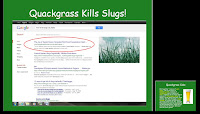Eight months ago – which now can be thought of as the ‘Before Time’ – I wrote about attending a talk by horticulturalist Dan Jaffe held at a garden club in a neighboring town. There, in front of 35 or 40 people, Dan put on a virtuoso performance under the most unimaginable of circumstances: he could not project his presentation onto a screen. Rather than cancel as would have been his right (the club had promised a compatible projector), Dan pivoted to a different strategy: he pared his visuals to a minimum and walked the room, holding his modest-sized laptop for groups to see.
 |
| I truly enjoy presentations |
Dan’s topic that evening was about incorporating native plants
into landscapes. He has dazzling visuals
for his presentations and he possesses an encyclopedic knowledge of his topic. But his hour-long talk was marred by technical glitches beyond his control: video freezes and audio that was often hard to hear.
At one point, his audience got a tour of Dan’s home as he moved from an office/study
to sit adjacent to his router in a different room. Further, Dan's slides aren't especially compatible with a small computer screen (see the photo at right). Most of his slides contain multiple images, which look fine when projected on a six- or eight-foot screen – but were difficult to absorb on a 14-inch monitor. And, without a laser pointer, deciphering which cultivar he was discussing was sometimes problematic. Also, in the February presentation, Dan was interrupted every few slides by questions from the audience, which added to everyone's understanding of the presentation, and had the added benefit of forcing Dan to slow down. On Wednesday evening, Dan fairly raced through his slides. All in all, it wasn’t
a disaster; just a disappointment.
 |
| Many of Dan's slides incorporate multiple images - hard to see on a small screen |
As much as I genuinely enjoy speaking to groups, I have turned
down several dozen remote speaking opportunities since Covid-19 became part of
our national language. I did so because I
did not think I could do justice to an audience. Mine is not a set of canned presentations; a group
of lectures that never need vary. Rather,
I continually ‘read’ my audience and adjust as I go. As a result, no two audiences ever see and
hear exactly the same talk. Also, my subject matter is tailored for a live audience. It is intended as entertainment; to make
people laugh (and laughter is infectious), and is ‘educational’ but certainly not 'education heavy'.
 |
| Zoom has become the de facto tool for enabling meetings |
Those requirements paled next to the elephant in the room:
that I would be unable to see or hear my audience. In my ‘dress rehearsal’ with the organizer, we
were one-on-one and I could see and hear her reactions. I could also see myself. I knew if I were properly positioned within
the camera’s frame and could judge whether my gestures were appropriate. I also
had that wonderful crutch offered to all users of PowerPoint: a miniature image
of my next slide alongside the current one. When you see a presenter doing
effortless segues between topics, it’s because of that ‘preview’ pane on his or
her laptop.
 |
| A speaker's best friend is the preview pane (in the lower right) showing the next slide |
I calmed down after a few slides and blew only one transition. But, in my own estimation, I did a mediocre job. I move around a fair amount and use hand gestures a great deal. Because I could not see myself, I rigidly stayed in one position and minimized gestures. I also went too fast (I know this because Betty kept holding up a sign that read SLOW DOWN!!!!).
Afterward, the organizer offered praise and said comments from
attendees were uniformly positive. I
respectfully disagree. I think I gave
the audience less than half of what they deserved. They got a well-rehearsed talk but there was
no spontaneity because I couldn’t see or hear their reactions. It was a two-dimensional talk that lacked
depth and shading.
 |
| I enjoy connecting with my audience (and, yes, selling books) |







